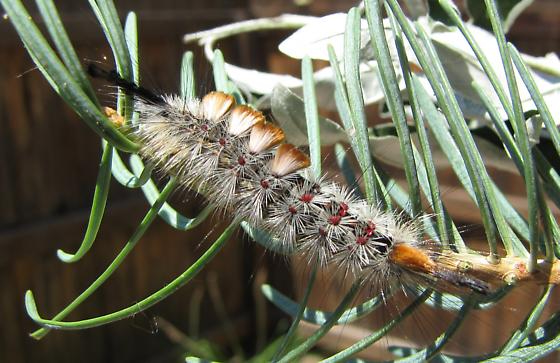As delicate and beautiful as they may initially appear, the Douglas-fir Tussock Moth (or more simply known as Tussock Moth), poses a significant threat to the lush greenery of our forests and our properties alike with their insatiable appetites. As their numbers surge, so does the urgency to address them.
Continue reading to answer the questions of what are these caterpillars and delve into some of the basics of the Douglas-fir Tussock Moth including their preferred targets, their natural controls and the debate surrounding the use of sprays as a mitigation technique.
WHAT THEY ARE?
Douglas-fir Tussock Moth (Orgyia pseudotsugata) is a moth that infests Douglas-fir, true firs, and spruce trees. The caterpillar of the moth eats at needles starting in the upper canopy of the tree and can cause defoliation and in extreme infestations, death.
WHAT DOES THE TUSSOCK MOTH ATTACK?
Tussock moths are known to attack firs and spruces. This includes Douglas-firs, true firs, and most notably in the front range, Colorado blue spruces. The damage is done in the caterpillar phase of life as the adults do nothing more than mate and die.
WHAT CAN I DO?
Tussock Moth infestations are normally controlled by natural methods such as predators and parasites and most importantly, Douglas-fir tussock moth nuclear polyhedrosis virus (NPV) or wilt disease. However, in some cases the level of caterpillars can reach outbreak levels and require additional methods to manage their population.
TO SPRAY OR NOT TO SPRAY?
Depending on your properties tree species density there may or may not be any reason to treat Tussock Moth. Sprays can be moderately invasive to small properties and need to be timed correctly to be effective. Sprays are not effective or ethical once the caterpillars begin to crawl on areas off the tree and form cocoons.
A quick note about common control methods: Many homeowners like to apply injection pesticides on single or pairs of larger fir trees that are adjacent to patios or decks as the caterpillars that fall from the trees can be very annoying. This can help to reduce the amount of spray pesticides used on a property and is effective for up to two years!
Whether you are a homeowner, arborist or simply just a nature enthusiast, understanding the Douglas-fir Tussock Moth and the nuance of an infestation is vital in safeguarding the verdant beauty of your landscape.
Want to discuss potential treatment options for your property? Give the Splintered Forest Plant Health Care team a call today or visit us online to schedule your free estimate!
Get informed about the Douglas-fir tussock moth. Understanding the behavior of the tussock moth is key to managing its impact on local trees.
Sources:
https://extension.colostate.edu/topic-areas/insects/5-542-douglas-fir-tussock-moths/
https://csfs.colostate.edu/forest-management/douglas-fir-tussock-moth/

